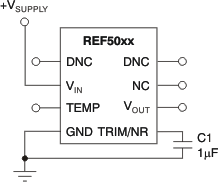SBOS410L June 2007 – October 2024 REF5010 , REF5020 , REF5025 , REF5030 , REF5040 , REF5045 , REF5050
PRODUCTION DATA
- 1
- 1 Features
- 2 Applications
- 3 Description
- 4 Device Comparison Table
- 5 Pin Configuration and Functions
- 6 Specifications
- 7 Parameter Measurement Information
- 8 Detailed Description
- 9 Applications and Implementation
- 10Power Supply Recommendations
- 11Layout
- 12Device and Documentation Support
- 13Revision History
- 14Mechanical, Packaging, and Orderable Information
Package Options
Mechanical Data (Package|Pins)
Thermal pad, mechanical data (Package|Pins)
Orderable Information
8.3.4 Noise Performance
Typical 0.1Hz to 10Hz voltage noise for each member of the REF50xx family is specified in the Electrical Characteristics table. The noise voltage increases with output voltage and operating temperature. Additional filtering can be used to improve output noise levels, although take care to make sure the output impedance does not degrade performance.
For additional information about how to minimize noise and maximize performance in mixed-signal applications such as data converters, refer to the How a Voltage Reference Affects ADC Performance Part 1, How a Voltage Reference Affects ADC Performance Part 2, and How a Voltage Reference Affects ADC Performance Part 3 analog design journals.
 Figure 8-4 Noise
Reduction Using the TRIM/NR Pin
Figure 8-4 Noise
Reduction Using the TRIM/NR Pin